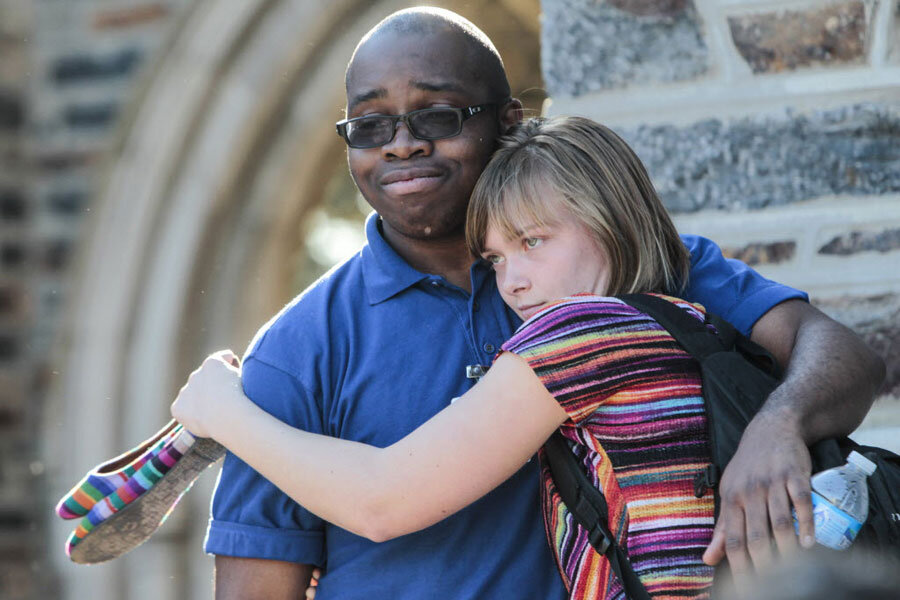Noose on Duke campus: Do colleges have a growing racism problem?
| Atlanta
Less than a week after the United States Department of Justice indicted a Georgia man for putting a noose around a civil rights statue at the University of Mississippi, students in Durham, N.C., early Wednesday discovered a noose hanging from a tree at Duke University.
The noose is the latest in a series of high-profile incidents at colleges in the United States, including revelations of racist fraternity chants at the University of Oklahoma and other schools, including Duke.
It is a jarring note for Millennials, who see themselves as a post-racial generation. But education analysts don't necessarily view the news with alarm. Data are not conclusive about whether the trend is growing, and college is precisely the place where many students get their first real introduction to what a diverse society looks like.
As America undergoes seismic changes demographically – transitioning to a country where whites will no longer be a majority – it makes sense that the struggle to come to terms would in many cases play out first on college campuses. The reaction to the incidents both from students and administrators points to the growing intolerance for such acts and the further progress that is necessary, experts say.
"A lot of people, even of the Millennial generation, grew up believing that this country would always look a certain way, and that the people who were in charge of major institutions would always be of a certain color," says Ed Dorn, a civil rights history professor at the University of Texas in Austin. "But the color line is shifting, and in a few decades this will no longer be a white man's country. That makes them uncomfortable, angry, and anxious."
The question of whether racist incidents are on the rise on campus is difficult to answer; news articles dating back to the 1980s decry the "new racism" on college campuses. The Office of Civil Rights in the US Department of Education reported 555 complaints based on race or ethnicity in 2009 and 860 such incidents in 2013. What's not fully understood is the the influence of social media in creating and publicizing such incidents. More reported incidents could be the product of more awareness – or not.
What is clearer is that talk about a "post-racial" generation is premature, and colleges have a chance to become a more significant player in the struggle to soothe racial animosity.
“Even when parents have positive racial attitudes, children can absorb the prejudices of their peers and the wider cultural milieu,” said Beverly Tatum, author of "Can We Talk About Race?" and president of Spelman College in Atlanta, to Inside Higher Ed this year. “We can be sure that all members of our campus population have come to college with stereotypes and prejudices about some other segment of our student body. As a result, higher education institutions have some of the greatest responsibility to challenge misconceptions and explore differences – and to help students develop their capacity to connect across them."
The challenge has been highlighted by recent events, including the federal hate crime indictment last week in the case of the statue of James Meredith at the University of Mississippi. Meredith integrated the University of Mississippi in 1962 with the help of armed guards. Last year, his statue was wrapped with a noose and a Confederate flag.
In addition, last month at the University of Washington, black students protesting police killings of young black males were called “apes” by counterprotesting white students. And last October, racist messages – including the phrase “Kill these n------!!” – were scrawled on dormitory room doors at the University of Massachusetts at Amherst.
"We're seeing a major pushback against the progress that's been made since the 1960s, and one manifestation of that is a racist song by a bunch of drunken fraternity members and incidents like [the noose at] Duke," says Professor Dorn. "It's also important to note that free expression on campus has traditionally not been sanctioned strongly, which means that a few 20-somethings on a college campus, fueled by a few beers, feel that they can get away with a few things. There's a reason we use the word 'sophomoric.' "
But school administrators also bear responsibility for creating a campus culture where racism is seen as acceptable, according to a January 2015 report by Harvard University’s Hutchins Center for African and African-American Research. The report noted that many schools created "by and for white men" have been less than welcoming to black students, "even when [they] have been recruited to attend."
At a Northeastern Ivy League school, the center found, black and Hispanic students claimed white students and faculty watched for them to confirm negative stereotypes. Yet there are positive examples, too. At a Southern university, one black study respondent said the school administration had admiringly endured death threats in order to remove racist imagery from campus, though noting that the university “still has a long way to go” in rooting out racism.
Part of the ongoing effort by universities to address racism is to use disturbing incidents as rallying points for racial solidarity.
At the University of Oklahoma, university officials quickly shut down the fraternity house that perpetuated the racist chant. Meanwhile, Duke University president Richard Brodhead gave a speech to thousands of students gathered to protest the noose, saying it is up to each student at the college to reject racism.
"One person put up that noose, but this is the multitude of people who got together to say that's not the Duke we want," he said. "That's not the Duke we're here for, and that's not the Duke we're here to create."







